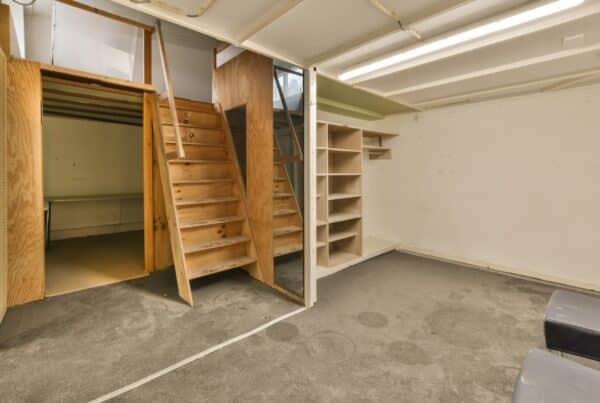Keeping your basement dry is essential to protecting your home and avoiding costly repairs. Water can creep in through cracks, seep up through the floor, or even linger in the air as moisture—and when it does, it often brings problems like mold, odors, or structural damage. Luckily, your basement will usually give you clues when something isn’t right with the waterproofing inside.
In this guide, we’ll explore three interior basement waterproofing red flags since recognizing them early can help you take action before the damage worsens.
Damp Walls or Persistent Moisture
Noticing damp spots or persistent moisture on your basement walls is a clear sign of waterproofing issues.
The moisture often enters through cracks in the foundation or walls, or due to inadequate drainage around your home. Over time, this can lead to mold growth, unpleasant odors, and structural damage.
Common Causes of Dampness:
- Cracks in the foundation or walls
- Poor exterior drainage
- Hydrostatic pressure

Efflorescence or Staining
Efflorescence is a chalky white residue that appears on basement walls when water evaporates and leaves behind mineral deposits. It’s a clear sign that water is seeping through the walls, even if the surface looks dry.
Staining, such as discoloration or streaks on walls, can also indicate ongoing water intrusion. These often result from porous materials like concrete or masonry allowing water to pass through.
As water moves, it carries dissolved salts that get left behind when the water evaporates. Efflorescence is not just cosmetic—it’s a red flag that moisture is entering your basement.
Common causes of efflorescence or staining:
- Water seeping through cracks or gaps in the walls
- High groundwater levels pressing against the foundation
- Poor grading or drainage systems around the home
If you spot efflorescence or stains on your basement walls, it’s a sign that waterproofing measures need attention. These indicators often precede more severe problems, like dampness or structural weakening.
Musty Smells and Mold Growth
A musty smell in your basement is often the first sign of hidden moisture problems. While basements can naturally feel cooler or more humid, a lingering musty odor usually signals water intrusion that has gone unchecked.
Unmanaged or undermanaged moisture creates the perfect environment for mold and mildew to grow, which can lead to health risks in the home. Since mold growth isn’t always visible, it can develop behind walls, in insulation, or in other hard-to-reach areas.
However, it’s often detectable through a distinct, earthy smell. When mold is visible, it typically appears as black, green, or white spots on surfaces like walls, floors, or ceilings.
Common causes of mold growth and musty odors:
- Persistent dampness or standing water
- Poor ventilation in the basement
- Lack of an effective waterproofing system
These signs should be taken seriously–they indicate that water is finding its way into your basement to worsen indoor air quality and cause potential respiratory problems.
Interior and Exterior Waterproofing
Basement waterproofing can be addressed through two primary methods: interior waterproofing and exterior waterproofing. Both play a critical role in managing water and protecting your home.
Interior waterproofing focuses on controlling water that has already entered the basement. This often involves:
- Installing drainage channels or systems to direct water to a sump pump
- Adding vapor barriers to reduce moisture on walls and floors
- Using dehumidifiers to manage indoor humidity levels
Exterior waterproofing prevents water from reaching the basement walls in the first place. Key methods include:
- Applying waterproof membranes or coatings to the exterior foundation
- Installing or maintaining French drains to redirect groundwater
- Ensuring proper grading around the home to move water away from the foundation
While exterior waterproofing is ideal for preventing water intrusion, interior waterproofing provides an effective solution for managing existing issues. In many cases, a combination of both methods ensures the best long-term protection.

During the process of waterproofing inside the basement
Other Recommended Maintenance
Taking preventative steps reduces the risk of basement waterproofing issues and protects your home from future damage.
For instance, some simple actions that can make a big difference:
- Inspecting walls and floors regularly for cracks and sealing them promptly
- Keeping gutters and downspouts clean and directing water away from the foundation
- Ensuring proper grading around the home to prevent water pooling near the basement
- Using a dehumidifier to control humidity levels and reduce moisture buildup inside
When to Call a Professional
Some waterproofing issues go beyond what simple fixes can address inside the basement. If you notice persistent moisture, visible signs of mold, efflorescence, or worsening structural damage, it’s time to call in a professional.
Professional waterproofing experts can:
- Identify the root causes of water intrusion
- Assess the extent of the damage
- Recommend and implement long-term solutions tailored to your home
Delaying action can lead to more severe and expensive problems, so reaching out for expert help early is the best way to protect your home.
Conclusion
Recognizing waterproofing red flags inside your basement—such as damp walls, efflorescence, or musty odors—can shield you from headaches and your home from harm. These signs are warnings that water is finding its way inside and affecting your home’s safety and structure.
If you’ve noticed any of these issues, don’t wait to take action. Contact Buckeye Basement Solutions for expert waterproofing services that keep your basement dry and your foundation stable.



